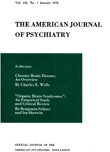THE USE OF A CONTROL POPULATION IN NEUROPSYCHIATRIC RESEARCH (PSYCHIATRIC, PSYCHOLOGICAL, AND EEG EVALUATION OF A HETEROGENEOUS SAMPLE)
Abstract
A heterogeneous control group of 151 young men drawn from 4 different socioeconomic sources, and a group of 40 patients in whom manifest anxiety was the predominant symptom, were studied by psychological, psychiatric and electroencephalographic means. The 4 subgroups of the control sample were contrasted with each other and with the patients.
The 4 control subgroups varied greatly and at a high level of statistical significance with regard to many psychological and psychiatric variables. Members of the total control group labeled by psychological and psychiatric means as emotionally unstable showed trends in their basic resting EEG similar to those found in the patient group. Many other indices often termed pathological occurred with equal or greater frequency among the controls than among the patients.
These results suggest that controls from different occupational, social, and economic sources may vary greatly in their psychiatric and psychological characteristics and thus a single source cannot be considered a random sample of the normal population. It seems essential, therefore, that investigators consider rather carefully what factors might affect the variable being studied and choose their control sample so as to randomize such factors or else rule them out experimentally or statistically. Any control group used needs to be carefully described in terms of source, education, and other factors possibly affecting the investigation. Furthermore, this study re-emphasizes the danger of hypothesizing that certain psychological or physiological characteristics can be considered as evidence of neuropsychiatric disease solely on the basis of their known occurrence in a patient population.
Access content
To read the fulltext, please use one of the options below to sign in or purchase access.- Personal login
- Institutional Login
- Sign in via OpenAthens
- Register for access
-
Please login/register if you wish to pair your device and check access availability.
Not a subscriber?
PsychiatryOnline subscription options offer access to the DSM-5 library, books, journals, CME, and patient resources. This all-in-one virtual library provides psychiatrists and mental health professionals with key resources for diagnosis, treatment, research, and professional development.
Need more help? PsychiatryOnline Customer Service may be reached by emailing [email protected] or by calling 800-368-5777 (in the U.S.) or 703-907-7322 (outside the U.S.).



